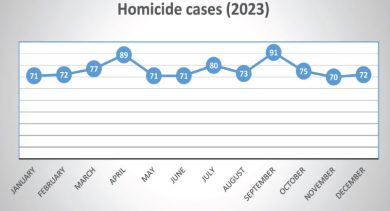Road to Canaan Just got longer
The National Planning Commission (NPC) yesterday said Malawi is unlikely to become a lower middle income country by 2030 and may only reach the goal 15 years later if it remains on the current lethargic path.
Updating the Budget and Finance Committee of Parliament in Lilongwe yesterday, NPC director general Thomas Munthali said a series of external crises that have spilled over to Malawi and internal catastrophes; have derailed the local economy from growing at the six percent minimum needed to reach the promised lands.
But exuding a cautiously optimistic tone, Munthali said if there is a radical course correction through implementation of catalytic interventions that can help chalk a consistent growth of 6.4 percent then Malawi could achieve the target by 2036—still a six-year drag on the target date.
Otherwise, he said, if government continues on the current trajectory, Malawi will only achieve the target of graduating to a lower middle-income economy with a gross national income per capita of $1 036 by 2045.

The local economy will, however, have to grow by at least 10 percent annually in the remaining six years to achieve the initial goal of graduating 2030, said Munthali.
But that, he said, will also require an infusion of private sector dynamism.
Said Munthali: “The major concern is that private sector dynamism and mindset change, a key enabler, have the highest number of interventions that have not yet commenced. Economic infrastructure is also experiencing delays with most of the road projects skewed towards road infrastructure.”
It might also require a small miracle in the new target areas of agriculture, tourism and mining (ATM), for the country to record double digit economic growth after the shrugging numbers recorded since 2020.
The Nation’s review of official Malawi Government figures show that over the past four years, real economic growth has hovered around two percent.
This growth rate is below the country’s population expansion pace of around 2.6 percent and falls short of the six percent benchmark that can enable the country to become a lower middle-income economy by 2030 and an upper middle income nation by 2063.
This year, national output is estimated at just 3.4 percent, according to Malawi Government figures.
The desmal progress towards Malawi2063 could undermine national efforts to reduce poverty and end inequalities, according National Working Group on Trade Policy chairperson Frederick Changaya.
Changaya’s concerns mirror those of NPC, which warns that the slow pace of the MW2063 agenda has undercut the progress the country made on United Nations Sustainable Development Goal (SDG) Two of eliminating hunger, and stalled advancements on creating decent work and promoting economic growth.
Government has said the Russian invasion of Ukraine—widely blamed for worsening global supply chain disruptions, which were triggered by Covid-19 lockdowns that reached their peak at the beginning of the Malawi2063 agenda in 2020—is one of the major outside forces scattering execution of its domestic agenda.
On the other hand, contends Capital Hill, disasters such as cyclones, the El-Nino weather patterns, widespread droughts that hit the dominant agriculture sector and destroyed some of the very infrastructure such as roads and power plants that drive growth, are also to blame.
But while independent economists from the private sector, the World Bank, International Monetary Fund and the African Development Bank (AfDB) agree that these shocks have negatively affected the country’s economic performance, some of these bodies say governance failures are also at the core of what ails Malawi.
Just this week, the AfDB said in its report that Malawi’s public finance management system continues to leak while other donors have said problems of misprocurement and weak accountability mechanisms exposed in every National Audit Office remain unaddressed.
But Government’s failure to prioritise and align public expenditure to MW2063 first 10-year implementation plan (MIP-1) covering the years 2020-2030, is also contributing to the sluggish progress, analysts say.
“The plan is failing because we have picked the wrong enablers. We needed to prioritise manufacturing because no country has developed from agriculture or mining. If we focus on these, then we will still have poor people because we are not generating enough.
“The key for Malawi is to catalyse economic growth at a level that is above the population growth rate. That will only be possible if we transition to manufacturing and industrialisation.”
Agreeing with Changaya, former Malawi Economic Justice Network executive director Dalitso Kubalasa said yesterday that Malawi will have to expedite reforms, particularly on the key enablers of Malawi 2063.
But Munthali said NPC remains optimistic that government can still turnaround the situation, especially given that implementation levels are getting better.
In his presentation to the committee, he said as of 2024, nearly halfway through the implementation period, government has executed 47 percent of the key interventions outlined in the MIP-1, representing a significant leap from just 20 percent in 2022.
The number of interventions that have not yet commenced has also dropped from 21 percent in 2022 to 16 percent.
Moreover, said Munthali, NPC is considering a proposal to create a budget framework that highlight key interventions, which would keep MW2063 on track while working with Parliament to ensure that national budgets speak to the vision and its 10-year implementation plans.
In a separate interview, Budget and Finance Committee of Parliament chairperson Ismael Mkumba urged NPC to present a formal proposal to Parliament on its planned interventions in the budget formulation process.






This piece was incredibly enlightening! The level of detail and clarity in the information provided was truly captivating. The extensive research and deep expertise evident in this article are truly impressive, greatly enhancing its overall quality. The insights offered at both the beginning and end were particularly striking, sparking numerous new ideas and questions for further exploration.The way complex topics were broken down into easily understandable segments was highly engaging. The logical flow of information kept me thoroughly engaged from start to finish, making it easy to immerse myself in the subject matter. Should there be any additional resources or further reading on this topic, I would love to explore them. The knowledge shared here has significantly broadened my understanding and ignited my curiosity for more. I felt compelled to express my appreciation immediately after reading due to the exceptional quality of this article. Your dedication to crafting such outstanding content is highly appreciated, and I eagerly await future updates. Please continue with your excellent work—I will definitely be returning for more insights. Thank you for your unwavering commitment to sharing your expertise and for greatly enriching our understanding of this subject.
I read this article completely regarding the comparison of newest and
previous technologies, it’s awesome article.
I am curious to find out what blog system you have been using?
I’m experiencing some small security problems with
my latest website and I would like to find something more safe.
Do you have any recommendations?
You actually make it seem so easy with your presentation however I in finding this topic to be really one thing which I think
I would by no means understand. It seems too complicated and extremely broad
for me. I am looking forward in your subsequent publish, I’ll attempt to get the cling of it!
Very rapidly this web page will be famous among all blogging and site-building
users, due to it’s nice articles or reviews
Hello there, You have done an incredible
job. I’ll definitely digg it and personally recommend to my friends.
I am confident they’ll be benefited from this web site.